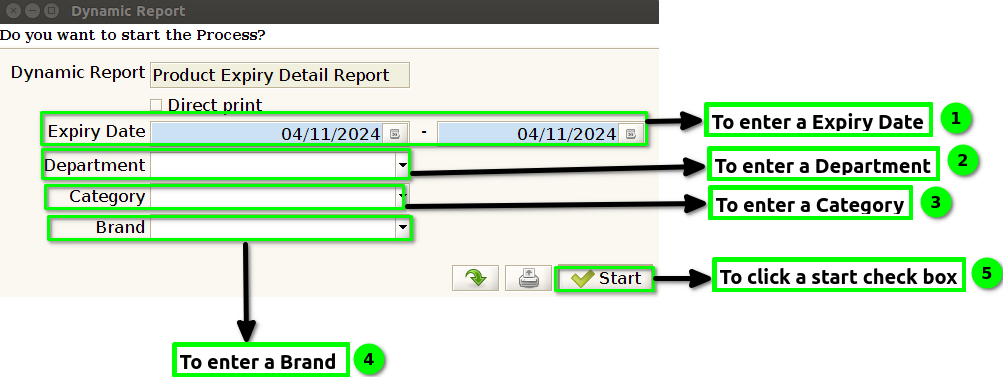TO CREATE A PRODUCT EXPIRY DETAIL REPORT-SS
A Product Expiry Detail Report is a document or report that provides information about the expiration dates of products in inventory.Product Information: Details such as the product name, SKU, or ID. Batch/Lot Number: Identifiers for specific production batches.Expiry Date: The date by which the product should be used or sold.Quantity on Hand: How many units of the product are currently in stock.Location: Where the products are stored in the warehouse or store.Days Until Expiry: A countdown of how many days are left before the product expires.
User Access
Who Can Access
- Pothys admin
- Back Office
- Purchase Manager
- Manager
What User Can Do
- View Reports
- Product Expiry Detail Report.
Pre-Requisite Activities
- Expiry Date
- Department
- Category
- Brand
Business Rules
- Data Inclusion Rule – Product Information: Include product name, SKU, category, and manufacturer.
- Expiry Dates: Capture the expiration date for each product.Current Inventory Levels: Include quantity on hand for each product.
- Location: Specify storage location (warehouse, store, etc.).Batch/Lot Number: Include batch or lot numbers for traceability.
- Reporting Frequency – Regular Reports: Generate the report weekly or monthly to keep track of near-expiry products.Ad-hoc Reports: Allow for on-demand reporting for specific inquiries.
- Thresholds for Expiry Alerts – Expiry Alert Period: Define the time frame for alerts (e.g., products expiring within 30, 60, or 90 days). Alert Mechanism: Notify relevant stakeholders (e.g., inventory managers) when products approach expiry.
- Filter and Sort Options – Filter by Expiry Date: Allow users to filter products by specific expiry date ranges.Sort Options: Enable sorting by expiry date, product name, or inventory levels.
- Data Accuracy and Integrity – Regular Updates: Ensure that inventory data is updated in real-time or at regular intervals.Validation Rules: Implement checks to prevent the entry of expired products into the inventory system.
- User Access and Security – Role-Based Access: Restrict report access based on user roles (e.g., inventory staff, management).Audit Trails: Maintain logs of who accessed or modified the report for accountability.
User Interface
STEP 1: To select a Product Expiry Detail Report.

STEP 2: To enter a Expiry Date(from date-to date).Then to enter a Department,Category and Brand based on our requirements.Date field is mandatory.Finally to click Start check box.

STEP 3:Once to run the process to show the report data’s based on our requirements.



STEP 4: product code- A product code is a unique identifier assigned to a specific product, often used to track inventory, sales, and other product-related data. SKU (Stock Keeping Unit): A unique code created by retailers to track products.UPC (Universal Product Code)-A barcode used mainly in North America for retail products.EAN (European Article Number)-Similar to UPC but used internationally.
product name-A product name is a distinctive title or label used to identify a specific product in the market. Branding- Helps to create a unique identity for the product, distinguishing it from competitors.Recognition-A memorable name aids in consumer recall and recognition.Marketing-It can convey the product’s benefits, features, or target audience, often influencing buying decisions.Legal Protection-A unique product name can be trademarked, offering legal protection against imitation.
product EAN- A product EAN (European Article Number) is a unique identifier assigned to a specific product, typically consisting of 13 digits. Identification: Each EAN corresponds to a specific product, allowing retailers and distributors to track stock and sales efficiently.Standardization: EANs are standardized internationally, facilitating trade across borders.Barcodes: EANs are often represented as barcodes.Global Trade: EANs help streamline logistics and inventory management in global supply chains.
MRP –Material Requirements Planning (MRP)– production planning, scheduling, and inventory control system used to manage manufacturing processes.
Expiry date -An expiry date is the date after which a product is no longer guaranteed to be effective or safe to use. It’s commonly found on food, pharmaceuticals, and other consumables. After this date, the product may deteriorate in quality, lose potency, or pose health risks.
GRN Doc No-The term “GRN” typically stands for “Goods Receipt Note.” It’s a document used in inventory and supply chain management to acknowledge the receipt of goods from a supplier. The “doc no” refers to the unique document number assigned to the GRN for tracking and record-keeping purposes.
GRN date-GRN date” typically refers to the date associated with a Goods Receipt Note (GRN). A GRN is a document used in inventory management to confirm the receipt of goods from a supplier. The GRN date is the date when the goods were received and documented, marking the point when the inventory is updated to reflect the new stock.
Department-A department is a distinct section within an organization, often characterized by specific functions, responsibilities, and roles. Departments help to organize the workforce and streamline operations.
Category-A product category is a grouping of products that share similar characteristics or fulfill similar needs.Types of Products-Categories can include broad classifications like electronics, clothing, or food.Subcategories: Within a broader category, there can be subcategories, like smartphones, laptops, and tablets within electronics.
Brand-A brand is the identity of a product, service, or company, encompassing its name, logo, design, messaging, and overall reputation in the marketplace. It reflects how a business presents itself and how it is perceived by consumers.
GRN Qty– GRN qty” typically refers to the “Goods Receipt Note quantity.” In inventory and supply chain management, a Goods Receipt Note is a document that records the receipt of goods delivered to a company. The “qty” indicates the quantity of items received as per the GRN.
Qty Onhand-Qty on hand refers to the quantity of a particular item that is currently available in stock or inventory. It indicates how many units of that item are physically present and ready for sale or use. This metric is important for inventory management, helping businesses track their stock levels and make informed decisions about ordering and restocking.
Training Videos
FAQ
SOP